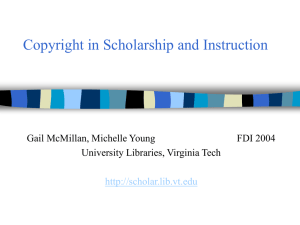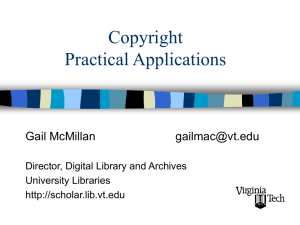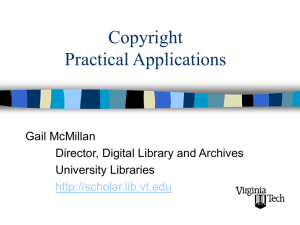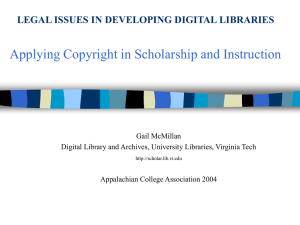Legal Tightrope Walking: Copyright and Fair
advertisement
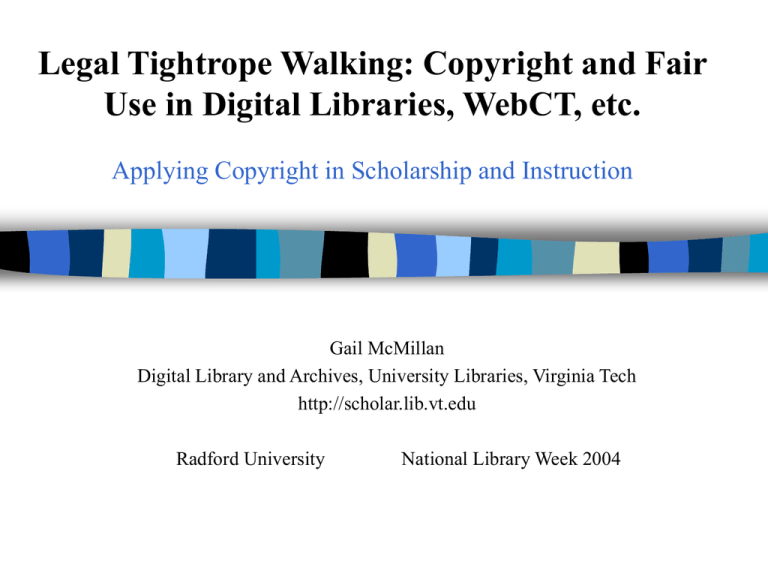
Legal Tightrope Walking: Copyright and Fair Use in Digital Libraries, WebCT, etc. Applying Copyright in Scholarship and Instruction Gail McMillan Digital Library and Archives, University Libraries, Virginia Tech http://scholar.lib.vt.edu Radford University National Library Week 2004 Copyright Law: U.S. Code, Title 17 © © Section 102: Original authorship stabilized Section 106: Exclusive rights of creators Limitations to exclusive rights © Section 107: Fair use © Section 108: Library services © Section 110: Instruction--TEACH Act http://fairuse.stanford.edu/ Rights of copyright holders 1. Reproduction 2. Modification 3. Distribution 4. Public performance 5. Public display Title 17 U.S.C. Sec. 106 Permission or license to use a copyrighted work is NOT required if Work is a fact or an idea – Phone number, earth is round Public domain – US government documents – Old: http://www.unc.edu/~unclng/public-d.htm Fair use – http://www.utsystem.edu/OGC/IntellectualProperty/copypol2.htm#test – TEACH Act Fair Use © Myth: It's OK--it's for educational purposes. Before using someone else's work without permission, weigh ALL 4 FACTORS 1. Purpose and character of use 2. Nature of the work 3. Amount, substantiality 4. Effect http://www.copyright.iupui.edu/ checklist.htm 1. Purpose and character of use Commercial or educational use For profit or not Degree of transformation; value added For criticism, commentary, news reporting, teaching, scholarship, research FAIR USE 1 of 4 2. Nature of the copyrighted work Worthy of (extensive) protection? Character of the work? – fact (information) or fiction (imaginative) • Published facts weigh in favor of fair use • Unpublished original expressions weigh in favor of seeking permission FAIR USE 2 of 4 3. Amount and substantiality Use only what is necessary Quantity and quality in relation to whole work FAIR USE 3 of 4 4. Effect Harm to potential market or value of a work after a portion has been used separately from the whole FAIR USE 4 of 4 Fair use Did the scales tip in favor of fair use after weighing all 4 factors? If not – Ask for permission – Use library services Title 17 U.S.C. Sec. 108 – Libraries can but individuals can’t Copyright permission services Copyright Clearance Center – http://copyright.com RSiCopyright – http://www.rsicopyright.com/ Association of American Publishers – http:// www.publishers.org You asked but they never responded. You don’t have permission. Copyright Resources Copyright Management Center (IUPUI) – http://www.copyright.iupui.edu/ Crash Course in Copyright (UTAustin) – http://www.utsystem.edu/OGC/IntellectualProperty/cprtindx.htm Library of Congress, Copyright Office – http://lcweb.loc.gov/copyright/ Legal Information Institute (Cornell) – http://www4.law.cornell.edu/uscode/17/ Stanford University Libraries – http://fairuse.stanford.edu TEACH Toolkit – http://www.lib.ncsu.edu/scc/legislative/teachkit/guidelines.html Copyright for Instruction USC Title 17 Section 110 – Limitations of certain performances and displays – Face-to-face classroom settings Broadened by TEACH Act (Nov. 2, 2002) – Must have an institutional copyright policy TEACH: Technology Education and Copyright Harmonization Act Fair use standards in digital education environment Modifies existing copyright law for: – – – – – – Accredited nonprofit educational institution Mediated instruction Integral part of class session Limited to enrolled students Accurately informed about copyright compliance Reasonably prevent • Retention beyond course • Unauthorized further dissemination TEACH Act: Works allowed Show entire nondramatic literary works – News, poetry, speech, charts, maps Show entire nondramatic musical works Everything else in reasonable and limited portions – Plays, movies, operas, TV shows, choreography USE IN DISTANCE LEARNING CLASS THE SAME AS IF IN THE CLASSROOM TEACH Act--You must not use Works marketed primarily for distance education Unlawfully made or acquired copies Materials meant for additional study outside of class – EReserve, Reserve, course management systems TEACH Act--You must Transmit as an integral part of class session regular part of systematic, mediated instruction Use copyrighted materials only when directly related to the lesson Limit access to students enrolled in the course Have an institutional copyright policy & inform students about © Block further dissemination Applying Copyright in Scholarship and Instruction Legal Tightrope Walking: Part 2 Gail McMillan Digital Library and Archives, University Libraries, Virginia Tech http://scholar.lib.vt.edu Radford University: National Library Week 2004

